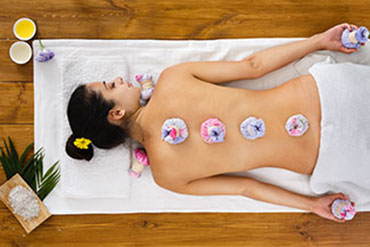 Generalized anxiety disorder (GAD) sufferers are often overly concerned about health issues, money, family problems or difficulties on the job. They can have negative, fearful thoughts about the future or suffer excessive guilt about some past event.
Generalized anxiety disorder (GAD) sufferers are often overly concerned about health issues, money, family problems or difficulties on the job. They can have negative, fearful thoughts about the future or suffer excessive guilt about some past event.
These concerns can last for months and are often groundless. Physical symptoms associated with GAD include muscle tension/aches, fatigue, headaches, difficulty swallowing, twitching, irritability, sweating, nausea, lightheadedness, frequent urination, hot flashes and shortness of breath.
Peer-reviewed medical research has shown that the benefits of massage include pain relief, reduced trait anxiety and depression, and temporarily reduced blood pressure, heart rate, and state of anxiety. Additional testing has shown an immediate increase and expedited recovery periods for muscle performance.
How Massage Helps Anxiety
Theories behind what massage might do include blocking nociception (gate control theory), activating the parasympathetic nervous system, which may stimulate the release of endorphins and serotonin, preventing fibrosis or scar tissue, increasing the flow of lymph, and improving sleep, but such effects are yet to be supported by well-designed clinical studies.
GAD affects about 6.8 million American adults. It affects twice as many women as men and its onset occurs gradually, beginning typically between childhood and middle age. A Surgeon General’s report on Mental Health revealed that 16% of adults between the ages of 18 and 54 suffer from various anxiety disorders for at least one year.
Therapeutic Massage for Anxiety and Stress
One way to reduce the symptoms of GAD is through massage therapy. Various forms of therapeutic superficial tissue manipulation have been practiced for thousands of years to treat anxieties of various sorts. Therapeutic massage can be helpful in reducing anxiety and stress. Massage was shown to promote relaxation and alleviate pain and anxiety in hospitalized cancer patients.
Massage therapy can act to cleanse the body of impurities. It can, for example, help break down built up toxins or waste in muscles, and often has a calming effect on anxious patients. A good massage performed by a trained professional can help you relax and soothe the aches and pains in various parts of your body.
While receiving a massage, one should avoid talking or dwelling on family, work or money matters. Instead, it’s best to relax and clear the mind. Keep in mind that it takes time for massage therapy to begin working. This means that persistent pains and tensions will require several sessions, so don’t expect immediate results.
There are several different types of massage available today. There’s Deep Tissue massage, which reaches deep into the sub-layer of musculature and fascia. Practitioners need advanced training and a thorough understanding of anatomy and physiology to correctly perform this technique.
Another popular technique is Swedish massage, which is a vigorous treatment designed to energize the body by stimulating circulation. It uses five basic strokes–kneading, rolling, vibration, percussive and tapping–to manipulate the body’s soft tissues.
Chinese self-massage techniques can also help relax your body, ease tension and reduce anxiety. These self-massage methods seek to restore balance and harmony of the body’s various parts.They stimulate the flow of qi by kneading, rubbing, slapping, pinching or gently pounding the surface of the body.
When suffering from GAD, first consult a primary care physician before attempting massage therapy. The may recommend the appropriate anti-anxiety treatment that is best suited for each individual case.
In addition to massage therapy, the doctor may suggest certain anti-anxiety medications, psychotherapy or counseling, or even herbal remedies. If massage is suggested, find a licensed massage therapist who is nationally certified through the National Certification Board for Therapeutic Massage and Bodywork.
Dr. Randi Fredricks, Ph.D.
Author Bio
Dr. Randi Fredricks is a leading expert in the field of mental health counseling and psychotherapy, with over three decades of experience in both research and practice. She holds a PhD from The Institute of Transpersonal Psychology and has published ground-breaking research on communication, mental health, and complementary and alternative medicine. Dr. Fredricks is a best-selling author of books on the treatment of mental health conditions with complementary and alternative medicine. Her work has been featured in leading academic journals and is recognized worldwide. She currently is actively involved in developing innovative solutions for treating mental health. To learn more about Dr. Fredricks’ work, visit her website: https://drrandifredricks.com

References
Calvert, R. (2002). The History of Massage: An Illustrated Survey from Around the World. Healing Arts Press.
Claire, Thomas (1995). Bodywork: What Type of Massage to Get and How to Make the Most of It. William Morrow and Co.
Lee, Eun Jin; Frazier, Susan K. (2011). The Efficacy of Acupressure for Symptom Management: A Systematic Review. Journal of Pain and Symptom Management. 42 (4): 589–603.
Upledger, JE (1995). Craniosacral therapy. Physical Therapy. 75 (4): 328–30.
Han M, Lee J (2011). Effects of foot reflexology on fatigue, sleep and pain: a systematic review and meta-analysis. J Korean Acad Nurs. 41: 821–33.
Moyer, CA; Rounds, J; Hannum, JW (2004). A meta-analysis of massage therapy research. Psychological Bulletin. 130 (1): 3–18.
